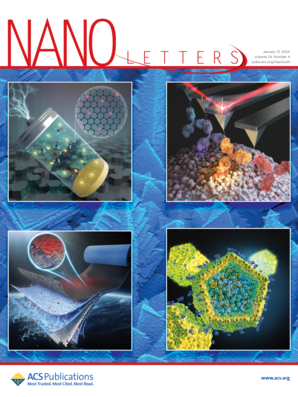Unraveling the Excited-State Dynamics of Er3+ in LiErF4-Based Upconversion Nanoparticles
IF 9.6
1区 材料科学
Q1 CHEMISTRY, MULTIDISCIPLINARY
引用次数: 0
Abstract
Lanthanide (Ln3+)-enriched upconversion nanoparticles (UCNPs) with high dopant concentrations have garnered significant attention due to their unique optical properties. However, their practical applications are hindered by the deleterious concentration quenching effect. Herein, through kinetic modeling of Er3+ excited-state dynamics employing energy diffusion theories, we demonstrate that concentration quenching in LiErF4 UCNPs predominantly originates from long-range energy migration through the 4I13/2 level toward surface and lattice defects, rather than the conventionally attributed cross-relaxation mechanism. Such migration-mediated energy dissipation can be effectively suppressed by the synergistic engineering strategies combining surface passivation, spatial confinement via a sandwiched LiYF4@LiErF4@LiYF4 core–shell–shell architecture to restrict Er3+ migration, and incorporation of Tm3+ as energy trapping centers, boosting upconversion quantum yield from <0.01% to 2.29% (980 nm@70 W cm–2). The established mechanistic framework and material design principles provide critical insights for engineering heavily doped UCNPs, particularly advancing their application potential in single-particle spectroscopy and optoelectronic nanodevices.

基于lierf4的上转换纳米颗粒中Er3+的激发态动力学研究
高掺杂浓度的富镧系(Ln3+)上转换纳米粒子(UCNPs)由于其独特的光学性质而引起了人们的广泛关注。然而,有害的浓度猝灭效应阻碍了它们的实际应用。本文采用能量扩散理论对Er3+激发态动力学进行动力学建模,证明了LiErF4 UCNPs中的浓度猝灭主要源于通过4I13/2能级向表面和晶格缺陷的远程能量迁移,而不是传统认为的交叉弛豫机制。这种迁移介导的能量耗散可以通过协同工程策略有效抑制,这些协同工程策略包括表面钝化、通过夹心LiYF4@LiErF4@LiYF4核壳壳结构限制Er3+迁移的空间约束以及加入Tm3+作为能量捕获中心,将上转换量子产率从<;0.01%提高到2.29% (980 nm@70 W cm-2)。所建立的机制框架和材料设计原则为高掺杂UCNPs的工程设计提供了重要的见解,特别是提高了它们在单粒子光谱和光电子纳米器件中的应用潜力。
本文章由计算机程序翻译,如有差异,请以英文原文为准。
求助全文
约1分钟内获得全文
求助全文
来源期刊

Nano Letters
工程技术-材料科学:综合
CiteScore
16.80
自引率
2.80%
发文量
1182
审稿时长
1.4 months
期刊介绍:
Nano Letters serves as a dynamic platform for promptly disseminating original results in fundamental, applied, and emerging research across all facets of nanoscience and nanotechnology. A pivotal criterion for inclusion within Nano Letters is the convergence of at least two different areas or disciplines, ensuring a rich interdisciplinary scope. The journal is dedicated to fostering exploration in diverse areas, including:
- Experimental and theoretical findings on physical, chemical, and biological phenomena at the nanoscale
- Synthesis, characterization, and processing of organic, inorganic, polymer, and hybrid nanomaterials through physical, chemical, and biological methodologies
- Modeling and simulation of synthetic, assembly, and interaction processes
- Realization of integrated nanostructures and nano-engineered devices exhibiting advanced performance
- Applications of nanoscale materials in living and environmental systems
Nano Letters is committed to advancing and showcasing groundbreaking research that intersects various domains, fostering innovation and collaboration in the ever-evolving field of nanoscience and nanotechnology.
 求助内容:
求助内容: 应助结果提醒方式:
应助结果提醒方式:


